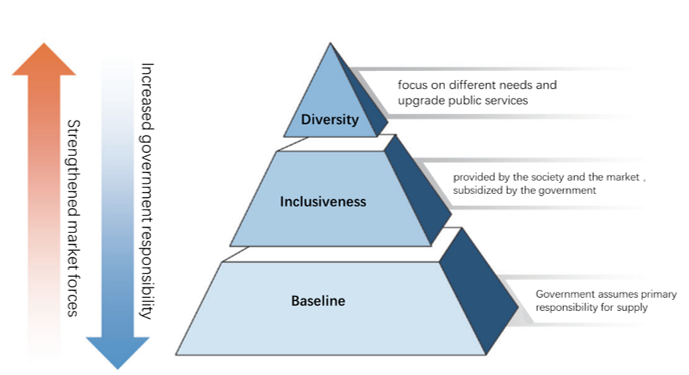



Abstract
The article analyzes the connotation of the strategy of actively coping with population aging under the Chinese modernization path from the perspectives of the needs of the elderly and macro policy transformation, including proactive government underwriting and supervision, effective market activation of resources, and high-quality diversified development of the elderly. On this basis, the article summarizes the limitations of the traditional technical paradigm of elderly service facility planning, and proposes optimization suggestions such as delineating the zoning of differentiated elderly service supply strategies, optimizing the allocation system and standards of developmental elderly service facilities, and strengthening the institutional guarantee for the revitalization of stock resources and multi-party co-operations.
Keywords
Chinese-style modernization; active response to population aging; planning of elderly service facilities
0 Introduction
Population aging is profoundly affecting various areas such as labor force, financial markets, housing, transportation, social security, family structure and intergenerational relationships. China has entered an aging society in 1999 and has become the country with the largest aging population in the world. Actively responding to population aging has become a national-level strategy.
In this context, how to actively respond to the traditional planning of elderly service facilities, especially how to prepare and implement the special planning of elderly service, is of great significance to practice the strategy of actively responding to the aging of population.
1 Main trends and characteristics of the demand shift of the aging population
1.1 Accelerated growth rate
China is currently facing the double pressure of large volume and rapid growth of aging. Under this trend, China is facing great challenges in terms of both the security system, medical conditions, wealth accumulation, and family structure. Thus, it is particularly important for the government to adapt to the current needs of the elderly by using affordable public expenditure and allocatable market forces.
1.2 Increased mobility and strong willingness to re-employ
The current aging has shown obvious characteristics of geographical mobility. Migrating elderly people have become a hidden demand group for elderly services in inflow areas that cannot be ignored and need to be fully considered in the planning.
In addition, the qualifications of China's elderly population are improving and there is a strong willingness to re-employ. Moderate activation of aging human resources can effectively supplement the gap in labor resources and play a positive role in socio-economic development.
1.3 Diverse needs of the elderly
China's elderly population also reflects the characteristics of diversified needs. The huge regional differences and spatial variations mean that local planning and policies for the supply of elderly service facilities need to be formulated according to the circumstances, so as to avoid the huge waste of resources brought about by a "one-size-fits-all" approach across the country.
2 Macro policies to actively respond to population aging
2.1 Multi-party participation in building the elderly service system
In recent years, the government has further clarified the different responsibilities and functional roles of the government, society and the market in the development of senior care services while strengthening the role of public senior care institutions in providing bottom-line protection. Our government is actively guiding the synergy of all parties to work together to alleviate the pressure of facility supply due to aging. Such a shift is conducive to alleviating the pressure on government public finance and improving the efficiency of government allocation of public resources, as well as taking into account the supply of accessible senior care facilities.
2.2 Emphasis on silver hair resources
The role of silver hair resources in the process of socio-economic development is shifting towards positive aspects. In recent years, the country has gradually formulated policies to release the dividends of the elderly population. Senior care services are no longer only public utilities, but also have comprehensive benefits in terms of human supply, service supply and socio-economic development. This requires urban planning to pay full attention to demographic development trends and to consider silver-haired resources as an important factor for urban development.
2.3 Diversification of elderly service system
Along with the continuous diversification of the needs of the elderly, the state has put forward more refined requirements for the types of demand and supply of elderly service facilities, not only limited to facilities to meet the needs of elderly services such as senior apartments, nursing homes and homes for the elderly, but also further proposed facilities such as senior dining tables and community hospice institutions.
3 Limitations of traditional elderly service facility planning
3.1 Emphasis on the allocation of total facilities, ignoring the operation mode
Under the influence of the government's bottom-up mentality, the planning of elderly service facilities generally focuses on total allocation, which can effectively transfer the higher-level constraint targets to local construction in a more direct manner. However, with the changes in demographic characteristics and policy orientation, the aggregate allocation model is difficult to effectively guide the old urban areas, which are mainly stocked, institutional facilities operated by multiple entities, and community elderly care institutions that are constantly decentering.
3.2 Focus on household registered population and neglect migrant elderly
At the urban scale, some cities have already put pressure on local supporting service facilities, jobs, and service consumption due to the periodic commuting of migrating elderly people, which is an issue easily ignored by planning.
In the community perspective, many new districts currently attract a large young population to settle down, but ignore the phenomenon of the elderly population periodically moving with them to take care of their families. The temporary relocation needs of these elderly people are more likely to be transformed into local elderly care needs in the future, which is bound to pose new challenges to planning.
3.3 Emphasis on single type of facility configuration, ignoring diversified needs
As the needs of the elderly change from survival-oriented to development-oriented, the planning paradigm limited to the spatial supply of elderly service facilities has become difficult to adapt to the current development. Current planning still lacks consideration for facilities that meet the social needs, psychological belonging, and self-development needs of the elderly.
4 Improvements in the planning of elderly service facilities
4.1 Develop a differentiated strategy for the supply of elderly services
The plan should firstly, from a systemic perspective, build a comprehensive assessment system based on population demand differences, facility supply pressure, economic support synergy, livable environment, etc.; secondly, set development goals in conjunction with the population aging strategy and delineate the zoning of differentiated elderly service supply strategies.
In the strategic sub-district, the first step is to determine the total amount and type of the facilities to be supplied by the government based on the affordability of the government's public finance. At the same time, it is necessary to determine the configuration requirements and service levels of market-based facilities through adequate market research. In addition, it is also necessary to form an ageing-friendly strategy based on the characteristics of employment, healthcare, culture, sports and other elements in the strategic sub-district.
4.2 Optimize the configuration system and standards of developmental elderly service facilities
On the basis of the delineation of the strategic zoning, the system, standards, site selection conditions and compatibility rules for the configuration of facilities within the strategic zoning should be further deepened.
At the same time, considering that the home - community elderly service facilities are an important carrier of the elderly service system that supports the combination of residence, health and recreation, it is recommended to develop standards for the construction of an elderly-friendly community living circle.
4.3 Strengthen the institutional guarantee of stock resource revitalization and multi-party co-operative
In terms of institutional guarantee, the focus is on the following: 1) Optimize the priority guarantee mechanism of land for elderly service facilities with full process convergence. 2) Guarantee the incremental supply of land for elderly service facilities. 3) Strengthen the tiered and graded supply of land indicators for elderly service facilities. 4) Increase the implementation policy support for building elderly service facilities with stock resources.
5 Conclusion
Population aging will be a long-term trend in China, and the proposed strategy of actively coping with population aging has pointed out the direction for converting the role of government, stimulating market vitality and the development of the elderly, and has also put forward new requirements for planning. Traditional special planning, configuration standards and implementation paths can hardly meet the demand for elderly service facilities under the current trend, and there is an urgent need to build a new theoretical framework, technical approach and standard system to provide accurate spatial supply and fine spatial governance for different cities and different types of elderly populations.
Source: <https://mp.weixin.qq.com/s/NpyNXY5Fznizc_1M6P7fsA>
Edited and translated by Hou Ying